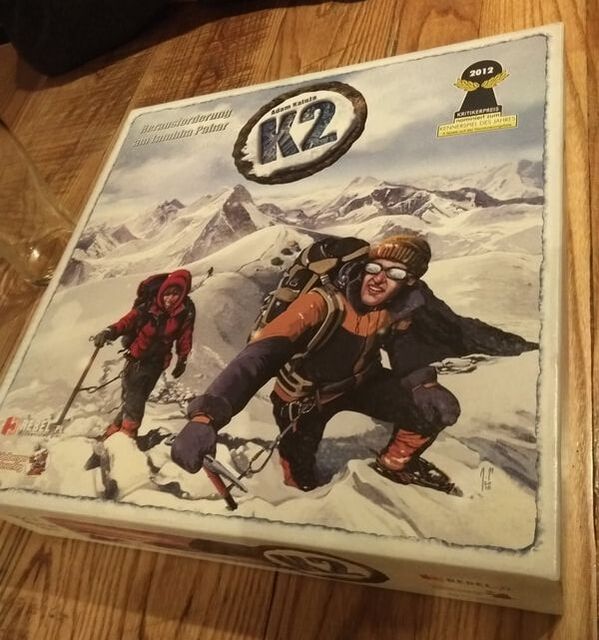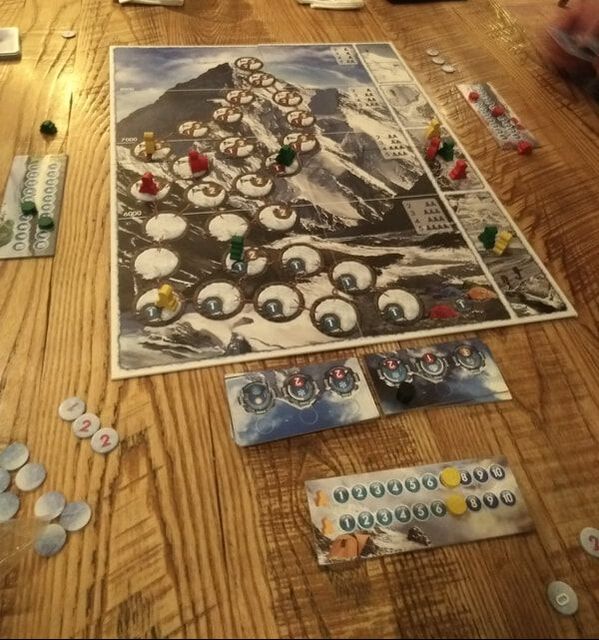|
19th March 2019. Another Tuesday and another evening of gaming fun at 'The Sovereigns' in Woking. Tonight we played in a 3 player game of 'K2'. K2 obviously refers to the mountain K2. People on the internet who claim to know more about mountain climbing than me (and that's not hard, I know nothing about mountain climbing) state that K2 is harder to climb than Everest. With that in mind, it's best that I conquer K2 from the confines of a board game sitting in a semi-comfy chair. In K2, each player controls 2 climbers. The higher a climber goes, the more points they score at the end of the game (provided they're still alive at the end). Each climber scores, so your final score will be the combined score of both. Climbers only have 1 stat for you to worry about and manage. That stat is 'acclimatisation'. If this drops to 0, then the climber dies. The game rules are quite straightforward. Each player has their own personal deck to draw cards from to create a hand of cards. There are basically 2 types of card.
Climbing to the top is simple, when you move one of your climbers to a new space on the mountain, it will have movement and acclimatisation cost that the climber must pay. Thus; if you have played a 3-point movement card and you moved a climber to a space that costs 2 movement, you would still have 1 movement left. At the end of a turn, climbers may gain or (most likely) lose acclimatisation points dependent on their position on the board. There you go, rinse and repeat until you reach the top. Simple, right. Except I've not mentioned 2 elements of the rules, which are what make K2 a good game.
The first is: The weather. You see, the weather can influence the movement costs of moving to another tile and also the acclimatisation costs that climbers must pay. Clear weather incurs no extra costs, but worse weather can affect, one, the other or both. Interestingly, the weather may only influence climbers at certain altitudes, it's possible to be above bad weather. The game uses tiles to depict the weather, each tile shows the weather for the next 3 days and there are always 2 tiles turned face up. When the end of the first weather tile is reached, a new tile is turned over. This means that players are able to see what the weather will be like for the next 3-6 days. Why does this make K2 a good game? It makes K2 a good game when combined with the other rule I was talking about, which is: The Hand of Cards Each player has 3 cards in their hand at the start of a turn. Players then draw 3 more cards from their decks. Giving them a hand size of 6. From this hand of 6, players must play any 3 cards. Leaving them with 3 cards remaining in their hand Why is this such a clever mechanic? Because it allows a player to plan their moves in for the future. Because you figuratively 'bank' 3 cards. When you play cards, the weather will influence how effective they are. This will influence which cards you play, but will also influence which cards you don't play. So when the weather forecast shows bad weather ahead, you don't want to be climbing much, because you'll be hindered and wasting movement. Any good movement cards should 'banked' and not played. Then, when eventually there's a stretch of good weather, hopefully you will have kept those good movement cards in your hand. So that regardless of what cards you draw, you'll have at least 3 good movement cards so that you can exploit the break in the bad weather to climb higher. That's why it's such a good mechanic, it emulates the feeling of sitting around in your tent enduring bad weather, waiting for a window of good weather to open up and then surging for the peak. There are some other rules about risk and turn order and like. But this is the gist of the game. And a good game it is.
0 Comments
Leave a Reply. |
AuthorI play, I paint. Archives
March 2024
Categories
All
|



 RSS Feed
RSS Feed
